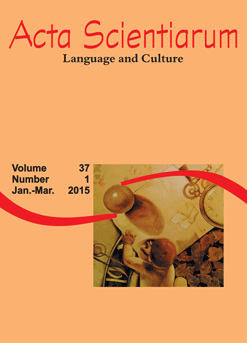<b>Sobre um hiper-romance ou a estrutura narrativa de <i>Se um viajante numa noite de inverno</i>, de Italo Calvino
Resumen
O romance Se um viajante numa noite de inverno (1979) encerra a produção ficcional de Italo Calvino da década de 1970, composta ainda por As cidades invisíveis (1972) e O castelo dos destinos cruzados (1973). Esses livros são resultantes de um intenso trabalho de pesquisa, com o qual Calvino busca e testa novas formas e materiais para composição literária, impactando notadamente a organização narrativa. A pesquisa objetivou estudar a estrutura narrativa de Se um viajante numa noite de inverno, buscando compreender como se dá a interação entre os diferentes níveis narrativos da obra. Para tanto foram realizadas análises descritivas desta e os dados obtidos foram estudados à luz do conceito de mise en abyme, reportados por Rita (2014), e das reflexões acerca dos pronomes pessoais no romance, expostas por Butor (1977) e Cacciatori (1990). Verificou-se que a estrutura narrativa divide-se em dois níveis distintos: romance-moldura e microrromances, que, por sua vez, se entrelaçam. Além disso, notou-se o emprego do recurso da mise en abyme, tanto no nível enunciativo quanto do enunciado, instaurando a relação especular. Concluiu-se que esses elementos são responsáveis pela articulação dos dois planos narrativos e pela organicidade da estrutura modular do romance.
Descargas
DECLARAÇÃO DE ORIGINALIDADE E DIREITOS AUTORAIS
Declaro que o presente artigo é original, não tendo sido submetido à publicação em qualquer outro periódico nacional ou internacional, quer seja em parte ou em sua totalidade.
Os direitos autorais pertencem exclusivamente aos autores. Os direitos de licenciamento utilizados pelo periódico é a licença Creative Commons Attribution 4.0 (CC BY 4.0): são permitidos o acompartilhamento (cópia e distribuição do material em qualqer meio ou formato) e adaptação (remix, transformação e criação de material a partir do conteúdo assim licenciado para quaisquer fins, inclusive comerciais.
Recomenda-se a leitura desse link para maiores informações sobre o tema: fornecimento de créditos e referências de forma correta, entre outros detalhes cruciais para uso adequado do material licenciado.




















6.png)









